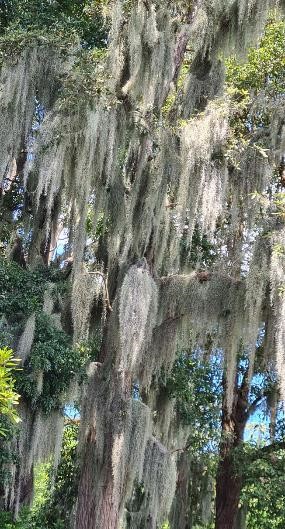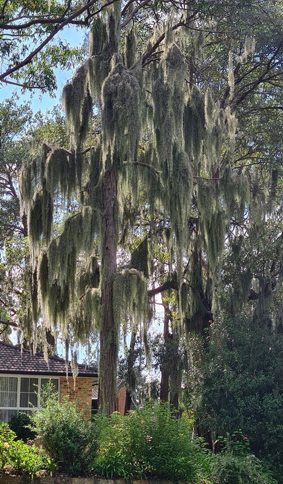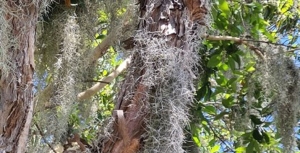Displaying items by tag: Spanish moss
Control
Spanish moss
Control
 We found no mention of an obvious biological control. Overseas examples of control include hand removal and spraying with potassium or sodium bicarbonate or copper sulphate.
We found no mention of an obvious biological control. Overseas examples of control include hand removal and spraying with potassium or sodium bicarbonate or copper sulphate.
Hand removal is often recommended as the best way to control Spanish moss but in our survey only approximately 12% was within easy reach. Rakes, ladders, professional tree climbers, industrial vacuum cleaners and specialised equipment such as spider lifts and elevated platforms would be needed in many infestations.
Spanish moss has been underestimated as a threat. We recommend that it be added to the next iteration of the Greater Sydney Regional Strategic Weed Management Plan, not be distributed or sold, and be added as a separate threat to Sydney Turpentine-Ironbark Forest in the Sydney Basin Bioregion.
Widespread education about its potentially disastrous impact on some bushland communities and urban forests is urgently needed through gardeners, horticulturalists, bushland managers and professional organisations.
Also, research is urgently needed into the ecology of Spanish moss, why it flourishes on some trees and not others, the ecological consequences of its presence as well as control methods suitable to Australian ecosystems and conditions.
Recommendations
Spanish moss
Recommendations
Individuals
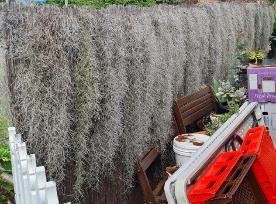
Remove all reachable festoons in your garden and put them into the green bin.
Control all festoons in garden trees by other means, e.g. spraying when safe effective methods have been established.
Do not give Spanish moss to friends, neighbours, passers-by and the local community.
Join campaigns to alert the local community and authorities to the threat posed by Spanish moss to bushland and gardens.
Authorities
Control authorities, e.g. state government, local councils, local land services and National Parks and Wildlife Service to urgently remove and control Spanish moss.
Educate the community about the threat posed by Spanish moss to bushland.
The Threatened Species Scientific Committee needs to add Spanish moss as a specific threat to the Critically Endangered Sydney Turpentine-Ironbark Forest.
Regulatory
Spanish moss must be added to:
- the next iteration of the Greater Sydney Regional Strategic Weed Management Plan and all other relevant regional strategic weed management plans
- these plans at a classification level that enables its eradication and containment, prohibition of sale and distribution, e.g. as a regional priority weed
Research
Immediate research is needed into:
- why Spanish moss flourishes on Turpentine, Brush Box and other rainforest species but not on most eucalypts
- the ecological consequences of infestation on individual trees and native plant communities
- the rate of growth and variation of growth with weather
- safe effective control options in Australian conditions
- fire ecology
Education
Education about the threat posed by Spanish moss to bushland through:
- TAFE NSW and private vocational providers – Spanish moss must be included on weed lists for horticultural, landscape, conservation and ecosystem management courses
- community groups – conservation groups (many are members of the Nature Conservation Council), gardening clubs (many are members of Gardening Clubs of Australia), Landcare, Greening Australia
- professional organisations – Australian Association of Bush Regenerators, The Society for Ecological Restoration Australasia, Ecological Society of Australia, Australian Institute of Horticulture
- gardening media – TV gardening and home improvement programs such as Gardening Australia, radio programs, magazines such as ABC Gardening Australia Magazine, Landscape Architecture Australia, Australian House & Garden
- social media – Facebook groups such as NSW Introduced Plant Identification and Bush Revegetation and Regeneration
Findings
Spanish moss
Findings
Spanish moss can grow almost anywhere, but during our survey it was obvious it flourished on some tree species and not others. Our observations indicate that the leachate from the host, or epiphytic species such as lichens and fungi, may be a determining factor for Spanish moss success. Spanish moss was recorded on trees from 32 plant families and 65% of records were from the Myrtaceae (Myrtle) family where turpentine and brush box dominated recordings. Of all the eucalyptus in the northern suburbs only one, red mahogany, was recorded repeatedly carrying substantial amounts of Spanish moss.
Festoons commonly occurred in the middle layer of the support plants (60%) and almost 90% were out of easy reach. Branches were the most common support (56%) followed by leaves, but only 12 host species (26%) were involved, primarily turpentines. Festoons were mostly 0.5 to 2 m long but some extended over 3 m. Sparse infestations were the norm (48%) but most individual festoons were dense.
Dispersal rate appears to have been slow with people and animals the main dispersal agents over long distances, but many observations indicate that the spread, density and size of festoons is increasing exponentially. It is no longer a sleeper weed.
Description
Spanish moss
Description
Spanish moss, commonly known as Old Man’s Beard, is a perennial monocotyledon in the pineapple family that grows abundantly from the Southern United States to the cooler regions of Argentina and Chile. It tolerates a huge range of temperatures and annual rainfall.
Spanish moss is an epiphyte that forms hanging festoons up to 8 m long which loop over branches and catch in cracks and crevices in bark to start new festoons. The festoons are made up of numerous shorter plants twisting around and overlapping each other.
It grows slowly, is not allelopathic nor drought tolerant, has low fertility requirements, is a medium moisture user, requires a pH of 6 to 6.9, has no salinity tolerance and is shade tolerant.
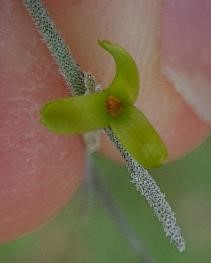
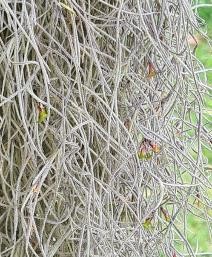
The small green flower is present from spring to autumn. The fruit is a capsule up to 25 mm long but we failed to find any mature fruit from November 2023 to June 2024. The flower rarely successfully self-pollinates. The seed is uncommon and is produced in autumn and winter. Seeds have feathery parachutes that enables them to float like dandelion seed. Seeds have no seed dormancy and can spread up to approximately 250 m away from the nearest Spanish moss but spread is not rapid under normal conditions.
The surface of Spanish moss plants is covered with tiny, grey scales (trichomes) that trap water and nutrients which then move by capillary action on the outside of the plant. Vascular transport is unimportant. Rain, dew and fog are more important than relative humidity. Water loss is reduced by crassulacean acid metabolism photosynthesis that allows gas exchange at night. In the Southern United States, Spanish moss is often found by ponds as clearing, frequent fires and barriers of dense pines prevent growth elsewhere. It generally grows best in high light conditions.
Spanish moss
Spanish moss
An environmental weed
In the early 2020s STEP became increasingly concerned about the potential impact of Spanish moss on our bushland and so we asked members to send us details of any Spanish moss growing on trees. In November 2024 we published the results of our findings in a booklet entitled Spanish Moss (Tillandsia usneoides): An Environmental Weed. A Preliminary Assessment in Northern Sydney.
We concluded that Spanish moss must be treated as a serious environmental weed otherwise turpentines, lilly pillys and other rainforest trees will turn into grey curtains of swaying Spanish moss. Local plant communities that are likely to be infected include the critically endangered Sydney Turpentine-Ironbark Forest, Blue Gum High Forest and Sydney Enriched Sandstone Moist Forest.
Threats to ecosystems include causing the death of individual trees by reducing photosynthesis but also include subtle effects such as altered water and nutrient cycles, changed predator prey interactions, habitat alteration, moderation of the microclimate and transformed fire regimes. Changes such as these are one of the greatest conservation threats to biodiversity in Australia.
Spanish moss will be expensive and difficult to control as most of it is out of easy reach. The sooner gardeners, park and natural area managers commence a coordinated program of removal the cheaper and more effective it will be.
Spanish moss
Would you like to take part in our citizen science project?
STEP is becoming increasingly concerned about the potential impact of the introduced Spanish moss on our bushland and so we are trying to establish where it is and on what trees it is growing.
How you can help
Please send details of any Spanish moss you see growing on trees to Robin Buchanan (This email address is being protected from spambots. You need JavaScript enabled to view it.). Ideally:
- send a geotagged photo (you may have to enable location) OR details of the location (e.g. street, park, suburb); and
- if known, the name of the host tree (common name is fine)

